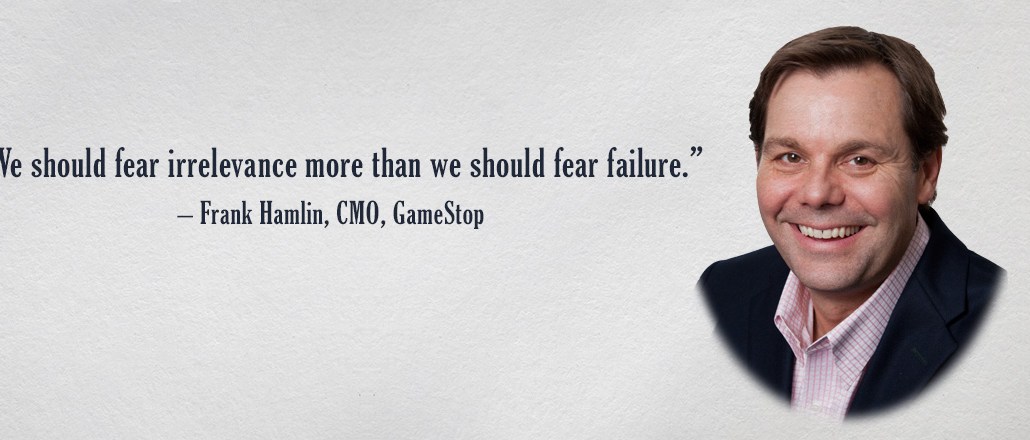GameStop CMO: ‘You have permission to fail, as long as you fail passionately’

This is ThinkTank, a new series from Digiday where we quiz CMOs and brand chiefs on where their industry is heading.
GameStop, which has 4,400 domestic storefronts, can evoke the feeling of a strip mall from the 90s.
But talk to CMO Frank Hamlin, and he’ll tell you it’s a brand for millennials. The company has a strong Twitter following, it hires knowledgeable associates who “speak the language,” and it’s succeeding in bringing the young consumer set in its doors.
“What we’re seeing is interesting, because it’s not stereotypical millennial behavior,” said Hamlin. “Our customers are 60 percent millennials, and they still want the in store, human interaction. As we get into what we’re doing from the marketing perspective, that’s where I’m focusing everything: on that store interaction, and using technology to enable better interactions in the store.”
For a retailer that relies on a rich in-store experience for its passionate community of gamers, being two steps ahead of the fast changing industry is key. Digiday spoke with Hamlin about operating a physical media retailer in 2015.
So the strategy is to work technology into the physical stores, rather than move to e-commerce?
We launched the GameStop Technology Institute last year, a business unit focused on just that — optimizing our stores with technology. We’ve since launched beacon technology in 38 stores and put tablets in the hands of every store associate to help their interactions with customers. For us, the physical presence is so important. Overall, our commerce business that’s shipped to home is only about 5 percent of our business. The trade-in program is huge: We gave customers $1 billion in trade value last year, and 70 percent of that was plowed back into their next gaming experience.
Do you have a millennial problem?
They say millennials want that instant gratification, but with us, they get it from the physical item in the store. It’s somewhat counterintuitive.
Ad position: web_incontent_pos1
Why do you think GameStop’s millennial customers are still shopping in store?
Eighty-five percent of our customers still prefer physical games. We sell what’s desirable to millennials, so there’s a great passion for it. It’s our store associates, too; they’re speaking the language and are one of them.
Are you worried about GameStop going the Blockbuster route?
Tony Bartel, our president, has a saying: “We should fear irrelevance more than we should fear failure.” I come from a place where I believe you have permission to fail, as long as you fail passionately. But we do need our rate of change internally to exceed our rate of change externally. What I say to my team is the hardest balance in business is changing it while you’re running it, but you have to do both constantly. We have customers in our stores right now, and we have to act upon that, but we have to be looking toward tomorrow.
How do you combat irrelevancy?
The GameStop brand is heavily focused on its culture and its core customer, and the key is to monitor where they’re going and what they’re thinking, and then be two steps ahead of them. We would be irrelevant if everyone went zag and we went zig. We need to constantly be dipping our toe in new waters and testing things like new platforms as much as we can, with a commitment to launch hard and fast when we see success. We have a huge following on Twitter, we’re testing out Instagram now, and we’ve had a lot of conversations about how we could use Snapchat, but we haven’t quite cracked it yet. I have a daughter who uses it, and it scares the hell out of me.
Coming from Guitar Center, do you draw any similarities at GameStop?
They’re both crafts of passion that have hardcore aficionados who make up a core part of the business. It’s religion, and it creates a fun ecosystem where everyone relies on each other. And the community helps bring in the younger consumers too, the Gen Z gamer, and that’s huge for us.
So video games might be one of the last standing types of media that certain people will actually go to the store for.
It’s misunderstood — everyone wants to draw the parallel between books and music, but it’s a much richer, more engaging form of media. When you put down sixty bucks for a game, you want a long, rich experience, and to keep a physical copy. People would probably keep buying movies if it was a movie that they continued to watch for six months. But, we’re agnostic. Where the customer goes, that’s where we’re ready to go. Right now, though, we’re not seeing the shift to digital at the level that you might think we are.
More in Marketing

In the marketing world, anime is following in the footsteps of gaming
As marketers look to take advantage of anime’s entry into the zeitgeist, they might be wise to observe the parallels between the evolution of anime as a marketing channel and the ways brands have learned to better leverage gaming in recent years.

With the introduction of video ads and e-commerce, Roblox looks to attain platform status
Roblox is expanding into more areas than just ads in 2024. Much like platforms such as Amazon and Facebook have transcended their origins to evolve from their origins as online marketplaces and social media channels, Roblox is in the midst of a transformation into a platform for all elements of users’ virtual lives.

PepsiCo wants to remain a ‘driver of culture’ as it turns to influencers and activations amid rebrand
The soda-maker says it can translate cultural relevance into sales volume.
Ad position: web_bfu